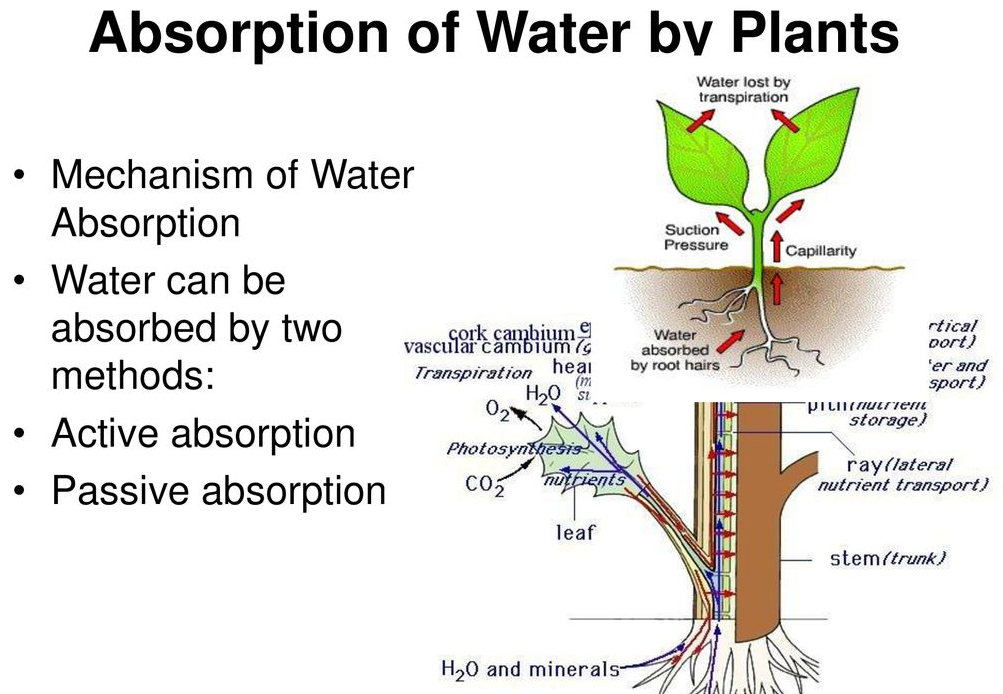How Is Water Absorbed By The Roots Of Plants
How much Absorption of Water In Plants are able to take in via their roots is influenced by both internal and external factors.
There are activities that efficiently absorb roots, transpiration, and metabolism, as well as soil factors (exogenous factors) like soil temperature, the solubility (osmotic potential) of the soil solution, soil aeration (concentration 02 and carbon dioxide accumulation), soil water, and soil aeration. Plant agents (internal factors) called root cells aid in water uptake by plants from the soil.
Absorption of Water in Plants

Soil factors affecting water absorption
Soil types are often the required to apply in water absorption, while meteorological variables may play a role: Among them are the following:
1. Soil temperature
The amount at which water is absorbed by the soil is affected by its temperature. Soils with a low temperature allow less water to be absorbed by plants. Root development is stunted at colder temperatures because root cells have a slower metabolic rate, water permeability to protozoa decreases, and water viscosity and fluidity increase. Extreme heat kills cells quickly. Absorption is greatest between 20 and 30 degrees Celsius.
2. Soil aeration
One of the most crucial elements in soil water absorption is air circulation. It’s well known that plants lose their leaves and water absorption slows in soil that doesn’t get enough air circulation, like buried earth (wither).
If the soil is waterlogged, the root system will perish from a lack of oxygen. Root development and cellular metabolism may be slowed by an oxygen deficit. Water potential gradients in cells are caused by salt accumulation, which may be mitigated by lowering metabolic activity.
Water absorption is slowed because protoplasm becomes more viscous when carbon dioxide builds up, reducing its permeability to water.
3. The soluble potential of the soil solution
Soil water absorption is driven by a potential gradient of water, which in turn is driven by the dissolved or potential osmotic potential of the soil solution.
Water will flow out from plant cells without being absorbed if the aqueous solution is more negative (less) than the root cell juice. This is why plant life struggles in areas with excessive salt levels. Plants that thrive in salty environments are called halophytes, and they can withstand very salty soil solutions.
4. Available water
Getting water from plants at a consistent wilt rate and above the level of retention of field water is challenging. Consequently, this is the optimal range for water absorption.
Water levels below the permanent wilt rate indicate the depletion of available water and signal the end of the absorption process if the water level rises over the field’s capacity, reducing the absorption rate.
Absorption of water by roots
Definite plant characteristics (internal factors) also impact root absorption of water and dissolved minerals in addition to external ones. Among them are:
1. Root system
Plants can more efficiently take up water-soluble nutrients from the soil if their root systems are big and they have an adequate amount of root hair. Grass, which is a dicotyledon, has a deeper root system than other plants because its fibers are so similar.
The hair root is crucial for taking in moisture. As these barriers are permeable, water may easily penetrate the soil solution. Furthermore, root hair expands the available absorption area. Fungi in the soil create mycorrhiza with the roots of most bare seeds. Soil moisture is retained with the aid of fungi.
2. Transpiration
The water loss due to transpiration is almost balanced by the water intake. The absorption rate is proportional to the transpiration rate. Transpiration, triggered by perspiration on the plant’s aerial portions, leads to water stress in the oblast and plastid. This suction induces a potential gradient in the water content of the soil solution. The water is soaked up more efficiently because of the gradient.
3. Root cell Metabolism activity
And besides debates regarding how much energy is really used during water absorption, the two processes are intrinsically linked. Inhibitors and obstructions to metabolism also slow down the absorption process. Inadequate ventilation and the use of respiratory depressants like potassium salts are two of these causes.
You Might Also Like: